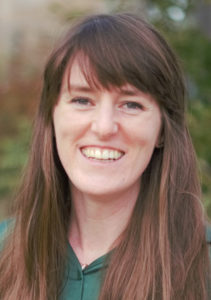 On Thursday October 26th 2023, we have the pleasure to welcome in SPINTEC Claire Donnelly from Max Planck Institute for Chemical Physics of Solids, Dresden, Germany and guest Professor at UGA for one month. She will give us a seminar at 10:00 entitled :
On Thursday October 26th 2023, we have the pleasure to welcome in SPINTEC Claire Donnelly from Max Planck Institute for Chemical Physics of Solids, Dresden, Germany and guest Professor at UGA for one month. She will give us a seminar at 10:00 entitled :
Mapping and controlling three dimensional topological magnetic textures
Place : IRIG/SPINTEC, auditorium 445 CEA Building 10.05 (access to CEA (*))
visioconference link : https://univ-grenoble-alpes-fr.zoom.us/my/olivier.fruchart
Abstract : Three dimensional magnetic systems promise significant opportunities for applications, for example providing higher density devices and new functionalities associated with complex topology and greater degrees of freedom [1,2]. Extending to three dimensions allows for the formation of new topologies of spin textures, for example containing defects in 3D such as Bloch point singularities, or truly three-dimensional topological structures such as magnetic hopfions.
In this talk, I will address two main questions: first, can we observe and understand such three-dimensional topological magnetic textures, and second, can we control them?
For the observation and understanding of these three-dimensional textures, we have developed magnetic X-ray tomographic techniques, that open the possibility to map both the three-dimensional magnetic structure [3], and its dynamical response to external excitations [4,5]. In this way, we observe 3D magnetic solitons which we identify as nanoscale magnetic vortex rings, as well as torons that contain Bloch point singularities [6,7].
As well as naturally existing within the bulk, 3D spin textures can be introduced and controlled via the patterning of 3D curvilinear geometries [8]. In this way, not only can new states be realized [9], but the energy landscape of topological defects can be designed through the local patterning of curvature induced chirality [11].
This new understanding and control of topological textures in 3D magnetic systems paves the way not only for enhanced understanding of these systems, but also towards the next generation of technological devices.
[1] Fernández-Pacheco et al., Nature Communications 8, 15756 (2017).
[2] C. Donnelly and V. Scagnoli, J. Phys. D: Cond. Matt. 32, 213001 (2020).
[3] C. Donnelly et al., Nature 547, 328 (2017).
[4] C. Donnelly et al., Nature Nanotechnology 15, 356 (2020).
[5] S. Finizio et al., Nano Letters (2022)
[6] C. Donnelly et al., Nat. Phys. 17, 316 (2020)
[7] N. Cooper, PRL. 82, 1554 (1999).
[8] D. Sheka, APL 118, 230502 (2021)
[9] C. Donnelly et al., Nature Nanotechnology 17, 136 (2022)
[10] S. Ruiz Gomez et al., In preparation
(*) Access to CEA requires an entry authorization. Request it sufficiently in advance : before October 19th at admin.spintec@cea.fr




